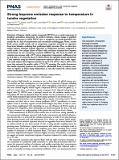Por favor, use este identificador para citar o enlazar a este item:
http://hdl.handle.net/10261/279837COMPARTIR / EXPORTAR:
 SHARE SHARE
 CORE
BASE CORE
BASE
|
|
| Visualizar otros formatos: MARC | Dublin Core | RDF | ORE | MODS | METS | DIDL | DATACITE | |

| Título: | Strong isoprene emission response to temperature in tundra vegetation |
Autor: | Seco, Roger CSIC ORCID ; Holst, Thomas; Davie-Martin, Cleo L.; Simin, Tihomir; Guenther, Alex; Pirk, Norbert; Rinne, Janne; Rinnan, Riikka | Palabras clave: | Temperature response VOC emission modeling Biogenic volatile organic compound fluxes Biosphere–atmosphere interactions Eddy covariance |
Fecha de publicación: | 20-sep-2022 | Editor: | National Academy of Sciences (U.S.) | Citación: | Proceedings of the National Academy of Sciences of the United States of America 119 (38) e2118014119 (2022) | Resumen: | Emissions of biogenic volatile organic compounds (BVOCs) are a crucial component of biosphere-atmosphere interactions. In northern latitudes, climate change is amplified by feedback processes in which BVOCs have a recognized, yet poorly quantified role, mainly due to a lack of measurements and concomitant modeling gaps. Hence, current Earth system models mostly rely on temperature responses measured on vegetation from lower latitudes, rendering their predictions highly uncertain. Here, we show how tundra isoprene emissions respond vigorously to temperature increases, compared to model results. Our unique dataset of direct eddy covariance ecosystem-level isoprene measurements in two contrasting ecosystems exhibited Q10 (the factor by which the emission rate increases with a 10 °C rise in temperature) temperature coefficients of up to 20.8, that is, 3.5 times the Q10 of 5.9 derived from the equivalent model calculations. Crude estimates using the observed temperature responses indicate that tundra vegetation could enhance their isoprene emissions by up to 41% (87%)-that is, 46% (55%) more than estimated by models-with a 2 °C (4 °C) warming. Our results demonstrate that tundra vegetation possesses the potential to substantially boost its isoprene emissions in response to future rising temperatures, at rates that exceed the current Earth system model predictions. | Versión del editor: | https://doi.org/10.1073/pnas.2118014119 | URI: | http://hdl.handle.net/10261/279837 | DOI: | 10.1073/pnas.2118014119 |
| Aparece en las colecciones: | (IDAEA) Artículos |
Ficheros en este ítem:
| Fichero | Descripción | Tamaño | Formato | |
|---|---|---|---|---|
| pnas.2118014119.pdf | Artículo principal | 1,26 MB | Adobe PDF |  Visualizar/Abrir |
| pnas.2118014119.sapp.pdf | Material suplementario | 1,26 MB | Adobe PDF |  Visualizar/Abrir |
CORE Recommender
PubMed Central
Citations
3
checked on 15-abr-2024
SCOPUSTM
Citations
16
checked on 15-may-2024
WEB OF SCIENCETM
Citations
11
checked on 28-feb-2024
Page view(s)
41
checked on 21-may-2024
Download(s)
149
checked on 21-may-2024
Google ScholarTM
Check
Altmetric
Altmetric
Artículos relacionados:
NOTA: Los ítems de Digital.CSIC están protegidos por copyright, con todos los derechos reservados, a menos que se indique lo contrario.
